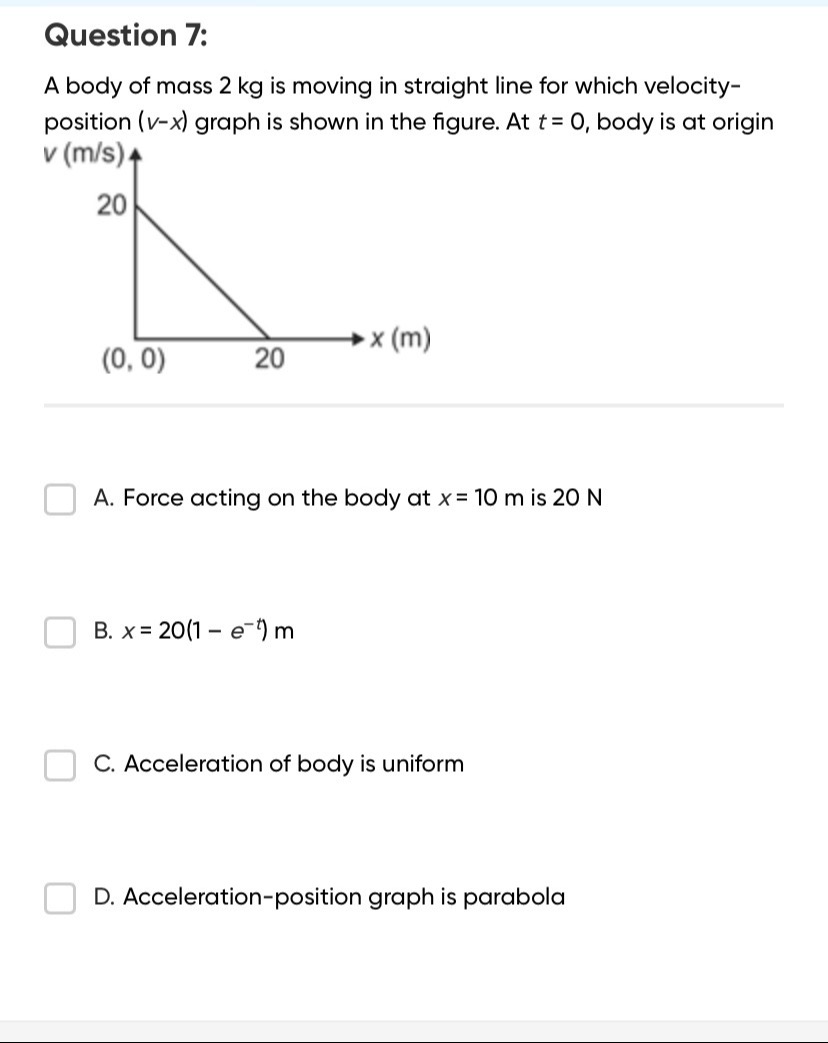Question
Question: A body of mass 2 kg is moving in straight line for which velocity-position (v-x) graph is shown in t...
A body of mass 2 kg is moving in straight line for which velocity-position (v-x) graph is shown in the figure. At t = 0, body is at origin

Force acting on the body at x = 10 m is 20 N
x = 20(1-e⁻ᵗ) m
Acceleration of body is uniform
Acceleration-position graph is parabola
A, B
Solution
The velocity-position (v-x) graph is a straight line passing through (0, 20) and (20, 0). The equation of this line is v(x)=20−x.
The acceleration of the body is given by a=vdxdv. From v(x)=20−x, we have dxdv=−1. Therefore, a=(20−x)(−1)=x−20. The mass of the body is m=2 kg. The force acting on the body is F=ma=2(x−20).
Analysis of options:
A. Force acting on the body at x = 10 m is 20 N At x=10 m, the acceleration is a=10−20=−10 m/s². The force is F=ma=(2 kg)(−10 m/s2)=−20 N. The magnitude of the force is ∣−20∣ N = 20 N. Assuming the question refers to the magnitude of the force, this statement is correct.
B. x = 20(1 - e⁻ᵗ) m We have a=dtdv. So, dtdv=x−20. Also, v=dtdx. From v=20−x, we get dtdx=20−x. This is a first-order linear differential equation: dtdx=20−x. Separating variables: 20−xdx=dt. Integrating both sides: ∫20−xdx=∫dt. This gives −ln∣20−x∣=t+C. Using the initial condition that at t=0, x=0, we get −ln∣20−0∣=0+C, so C=−ln(20). Substituting C back: −ln∣20−x∣=t−ln(20). Rearranging: ln∣20−x∣=ln(20)−t. Exponentiating both sides: ∣20−x∣=eln(20)−t=eln(20)e−t=20e−t. Since v=20−x and v(0)=20 m/s, and v decreases as x increases, v is positive for x<20. Thus, 20−x>0. So, 20−x=20e−t. This yields x=20−20e−t=20(1−e−t). This statement is correct.
C. Acceleration of body is uniform The acceleration is a(x)=x−20. Since x changes with time, the acceleration is not constant and therefore not uniform. This statement is incorrect.
D. Acceleration-position graph is parabola The acceleration-position graph is given by a(x)=x−20. This is a linear equation, representing a straight line, not a parabola. This statement is incorrect.
